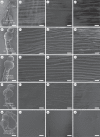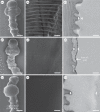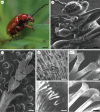A 'NanoSuit' surface shield successfully protects organisms in high vacuum: observations on living organisms in an FE-SEM
- PMID: 25631998
- PMCID: PMC4344158
- DOI: 10.1098/rspb.2014.2857
A 'NanoSuit' surface shield successfully protects organisms in high vacuum: observations on living organisms in an FE-SEM
Abstract
Although extremely useful for a wide range of investigations, the field emission scanning electron microscope (FE-SEM) has not allowed researchers to observe living organisms. However, we have recently reported that a simple surface modification consisting of a thin extra layer, termed 'NanoSuit', can keep organisms alive in the high vacuum (10(-5) to 10(-7) Pa) of the SEM. This paper further explores the protective properties of the NanoSuit surface-shield. We found that a NanoSuit formed with the optimum concentration of Tween 20 faithfully preserves the integrity of an organism's surface without interfering with SEM imaging. We also found that electrostatic charging was absent as long as the organisms were alive, even if they had not been coated with electrically conducting materials. This result suggests that living organisms possess their own electrical conductors and/or rely on certain properties of the surface to inhibit charging. The NanoSuit seems to prolong the charge-free condition and increase survival time under vacuum. These findings should encourage the development of more sophisticated observation methods for studying living organisms in an FE-SEM.
Keywords: NanoSuit; field emission scanning electron microscope; high vacuum; living organism; surface shield effect.
© 2015 The Author(s) Published by the Royal Society. All rights reserved.
Figures




References
-
- Knoll M. 1935. Aufladepotentiel und Sekundäremission elektronenbestrahlter Körper. Z. Techn. Phys. 16, 467–475.
-
- Symondson WOC, Williams IB. 2003. Low-vacuum electron microscopy of carabid chemoreceptors: a new tool for the identification of live and valuable museum specimens. Entomol. Exp. Appl. 85, 75–82. (10.1046/j.1570-7458.1997.00235.x) - DOI
-
- Danilatos GD. 1991. Review and outline of environmental SEM at present. J. Microsc. 162, 391–402. (10.1111/j.1365-2818.1991.tb03149.x) - DOI
MeSH terms
Substances
LinkOut - more resources
Full Text Sources
Other Literature Sources
